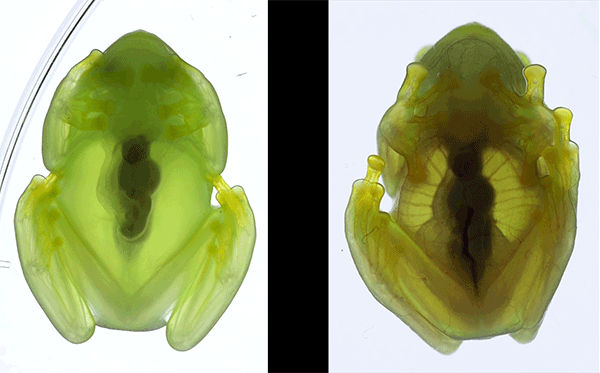Hello Nature readers, would you like to get this Briefing in your inbox free every day? Sign up here

A glassfrog, shown asleep (left) and awake and active (right). Credit: Jesse Delia
Glass frogs hide their blood when they sleep
The glass frog (Hyalinobatrachium fleischmanni) can turn two or three times more transparent when it sleeps, by hiding almost all of its red blood cells in its liver. The organ conceals the blood with a coating of reflective crystals, making the frog almost invisible to predators. It remains a mystery how the frog survives the feat: during this time, it has almost no circulating oxygen and concentrates so much blood in its liver that it should end up with fatal clotting.
Mitochondrial transplant shows promise
In a world first, six children with rare disorders caused by deletions in the genomes of their mitochrondria — the cellular compartments essential for energy generation — have been successfully treated with donor mitochondria from their mothers. Doctors transferred healthy mitochondria into the children’s haematopoietic stem cells, which give rise to the body’s blood cells. After the treatment, tests showed that some of the children were stronger and had reached healthier weights, and caregivers said they spent more time awake and in play. “These are very soft measures that are hard to report, but we did see major improvements to the quality of life in almost all of these children,” says paediatric haematologist Elad Jacoby, who led the study. A clinical trial of the approach, known as mitochondrial augmentation therapy, is expected to start next year.
Reference: Science Translational Medicine paper
Henrietta Lacks honoured with statue
A bronze statue of Henrietta Lacks will be erected in her home town of Roanoke, Virginia, on the site of a monument to Confederate leader Robert E. Lee that was toppled during Black Lives Matter protests in 2020. In 1951, doctors took cells from Lack’s cervical cancer shortly before her death without her knowledge or consent, and used them to create the first indefinitely multiplying human cell line, ‘HeLa’. The cell line has become a mainstay of biomedical research, used in breakthroughs including the development of the polio vaccine. Lacks was commemorated last year with a statue at the University of Bristol, UK, dedicated “to all the unrecognised black women who have contributed to humanity”.
Read more in Nature about the woman behind HeLa and the rocky path to justice for the Lacks family.
Features & opinion
No room for COVID complacency in 2023
The COVID-19 wave currently sweeping through China shows that the pandemic is not over. Ignoring the devastation the disease continues to cause means that public-health authorities risk being unprepared when the next variant of concern — or the next pandemic pathogen — emerges, argues a Nature editorial. It calls for the global community to reckon with the politics that undermined global vaccine distribution, and strengthen health-care systems for the next threat.
Merry Christmas from the Bremmers
A Christmas letter looks on the bright side of post-apocalyptic life in the latest short story for Nature’s Futures series.
Five best science books this week
Andrew Robinson’s pick of the top five science books to read this week includes the history of US health inequity, a vision for the Moon and a life of “determined autodidact” Freeman Dyson.
Podcast: Nature’s 10
In this week’s Nature Podcast, the team highlights some of the people who helped shape science this year including JWST astronomer Jane Rigby, voice for Ukraine Svitlana Krakovska and mpox researcher Dimie Ogoina. Plus, play along with a round of ‘what’s behind the headline?’ and enjoy our annual silly science-themed carols.
Nature Podcast | 35 min listen
Subscribe to the Nature Podcast on Apple Podcasts, Google Podcasts or Spotify.
